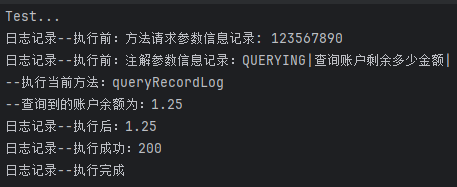本文主要以日志记录作为切入点,来讲解Spring AOP在实际项目开发中怎样更好的使项目业务代码更加简洁、开发更加高效。
日志处理只是AOP其中一种应用场景,当你掌握了这一种场景,对于其它应用场景也可以游刃有余的应对。
AOP常见的应用场景有:日志记录、异常处理、性能监控、事务管理、安全控制、自定义验证、缓存处理等等。文末会简单列举一下。
在看完本文(日志记录场景)后,可以练习其它场景如何实现。应用场景万般种,万变不离其中,掌握其本质最为重要。
使用场景的本质 是:在一个方法的执行前、执行后、执行异常和执行完成状态下,都可以做一些统一的操作。AOP 的核心优势在于将这些横切功能从核心业务逻辑中提取出来,从而实现代码的解耦和复用,提升系统的可维护性和扩展性。
案例一:简单日志记录
本案例主要目的是为了理解整个AOP代码是怎样编写的。
引入依赖
xml
<dependency>
<groupId>org.springframework.boot</groupId>
<artifactId>spring-boot-starter-aop</artifactId>
</dependency>自定义一个注解类
java
import java.lang.annotation.ElementType;
import java.lang.annotation.Retention;
import java.lang.annotation.RetentionPolicy;
import java.lang.annotation.Target;
// 日志记录注解:作用于方法
@Target(ElementType.METHOD)
@Retention(RetentionPolicy.RUNTIME)
public @interface RecordLog {
String value() default "";
}编写一个切面类Aspect
AOP切面有多种通知方式:@Before、@AfterReturning、@AfterThrowing、@After、@Around。因为@Around包含前面四种情况,本文案例都只使用@Around,其它可自行了解。
java
import org.aspectj.lang.ProceedingJoinPoint;
import org.aspectj.lang.annotation.Around;
import org.aspectj.lang.annotation.Aspect;
import org.springframework.stereotype.Component;
@Aspect
@Component
public class RecordLogAspect {
// 指定自定义注解为切入点
@Around("@annotation(org.example.annotations.RecordLog)")
public void around(ProceedingJoinPoint proceedingJoinPoint){
try {
System.out.println("日志记录--执行前");
proceedingJoinPoint.proceed();
System.out.println("日志记录--执行后");
} catch (Throwable e) {
// e.printStackTrace();
System.out.println("日志记录--执行异常");
}
System.out.println("日志记录--执行完成");
}
}编写一个Demo方法
java
import org.example.annotations.RecordLog;
import org.springframework.stereotype.Component;
@Component
public class RecordLogDemo {
@RecordLog
public void simpleRecordLog(){
System.out.println("执行当前方法:"+Thread.currentThread().getStackTrace()[1].getMethodName());
// 测试异常情况
// int a = 1/0;
}
}进行单元测试
java
import org.example.demo.RecordLogDemo;
import org.junit.jupiter.api.Test;
import org.springframework.beans.factory.annotation.Autowired;
import org.springframework.boot.test.context.SpringBootTest;
@SpringBootTest
class SpringDemoAOPApplicationTests {
@Autowired
private RecordLogDemo recordLogDemo;
@Test
void contextLoads() {
System.out.println("Test...");
recordLogDemo.simpleRecordLog();
}
}测试结果:

这是最简单的日志记录,主要目的是理解整个代码是怎样的。
案例二:交易日志记录
本案例完成切面类根据外部传进来的参数实现动态日志的记录。
切面获取外部信息的一些方法:
-
获取目标方法(连接点)的参数:
JoinPoint类下的getArgs()方法,或ProceedingJoinPoint类下的getArgs()方法 -
获取自定义注解中的参数:自定义注解可以定义多个参数、必填参数、默认参数等
-
通过抛出异常来传递业务处理情况,切面通过捕获异常来记录异常信息
也可以根据方法参数的名称去校验是否是你想要的参数 String[] paramNames = ((MethodSignature) joinPoint.getSignature()).getParameterNames();
切面获取内部信息:比如获取执行前后的时间。
调整后的代码如下
新增了枚举类
java
public enum TransType {
// 转账交易类型
TRANSFER,
// 查询交易类型
QUERYING;
}自定义注解类
注解多了必填的交易类型和选填的交易说明
java
import org.example.enums.TransType;
import java.lang.annotation.ElementType;
import java.lang.annotation.Retention;
import java.lang.annotation.RetentionPolicy;
import java.lang.annotation.Target;
// 日志记录注解:作用于方法
@Target(ElementType.METHOD)
@Retention(RetentionPolicy.RUNTIME)
public @interface RecordLog {
// 必填的交易类型
TransType transType() ;
// 选填的交易说明
String description() default "";
}切面类
新增了开头所说的三种获取外部信息的代码
java
import org.aspectj.lang.ProceedingJoinPoint;
import org.aspectj.lang.annotation.*;
import org.aspectj.lang.reflect.MethodSignature;
import org.example.annotations.RecordLog;
import org.example.enums.TransType;
import org.springframework.stereotype.Component;
import java.lang.reflect.Method;
@Aspect
@Component
public class RecordLogAspect {
// 指定自定义注解为切入点
@Around("@annotation(org.example.annotations.RecordLog)")
public Object around(ProceedingJoinPoint proceedingJoinPoint){
// 1.获取目标方法(连接点)的参数信息
Object[] args = proceedingJoinPoint.getArgs();
// 获取特定类型的参数:根据具体情况而定
for (Object arg : args) {
if (arg instanceof String) {
System.out.println("日志记录--执行前:方法请求参数信息记录: " + arg);
}
}
// 2.获取自定义注解中的参数
MethodSignature methodSignature = (MethodSignature)proceedingJoinPoint.getSignature();
Method method = methodSignature.getMethod();
RecordLog annotation = method.getAnnotation(RecordLog.class);
// 交易类型
TransType transType = annotation.transType();
// 交易描述信息
String description = annotation.description();
try {
System.out.println("日志记录--执行前:注解参数信息记录:"+transType+"|"+description+"|");
Object proceed = proceedingJoinPoint.proceed();
System.out.println("日志记录--执行后:"+proceed.toString());
// 只要没异常,那就是执行成功
System.out.println("日志记录--执行成功:200");
return proceed;
} catch (Throwable e) {
// e.printStackTrace();
// 3.捕获异常来记录异常信息
String errorMessage = e.getMessage();
System.out.println("日志记录--执行异常: "+errorMessage);
throw new Exception("日志记录--执行异常: ").initCause(e);
} finally {
System.out.println("日志记录--执行完成");
};
}
}新增了业务相关类
java
public class TransInfoBean {
private String transStatusCode;
private String transResultInfo;
private String account;
private BigDecimal transAmt;
public String getTransStatusCode() {
return transStatusCode;
}
public void setTransStatusCode(String transStatusCode) {
this.transStatusCode = transStatusCode;
}
public String getTransResultInfo() {
return transResultInfo;
}
public void setTransResultInfo(String transResultInfo) {
this.transResultInfo = transResultInfo;
}
public String getAccount() {
return account;
}
public void setAccount(String account) {
this.account = account;
}
public BigDecimal getTransAmt() {
return transAmt;
}
public void setTransAmt(BigDecimal transAmt) {
this.transAmt = transAmt;
}
}业务Demo类
加入了外部参数注解、方法参数和异常,只要交易失败都要抛出异常。
java
import org.example.annotations.RecordLog;
import org.example.enums.TransType;
import org.springframework.stereotype.Component;
import java.math.BigDecimal;
@Component
public class RecordLogDemo {
@RecordLog(transType = TransType.QUERYING,description = "查询账户剩余多少金额")
public BigDecimal queryRecordLog(String account) throws Exception {
System.out.println("--执行当前方法:"+Thread.currentThread().getStackTrace()[1].getMethodName());
try{
// 执行查询操作:这里只是模拟
TransInfoBean transInfoBean = this.queryAccountAmt(account);
BigDecimal accountAmt = transInfoBean.getTransAmt();
System.out.println("--查询到的账户余额为:"+accountAmt);
return accountAmt;
}catch (Exception e){
throw new Exception("查询账户余额异常:"+e.getMessage());
}
}
/**
* 调用查询交易
* @param account
* @return TransInfoBean
*/
private TransInfoBean queryAccountAmt(String account) throws Exception {
TransInfoBean transInfoBean = new TransInfoBean();
transInfoBean.setAccount(account);
try{
// 调用查询交易
// int n = 1/0;
transInfoBean.setTransAmt(new BigDecimal("1.25"));
//交易成功:模拟交易接口返回来的状态
transInfoBean.setTransStatusCode("200");
transInfoBean.setTransResultInfo("成功");
}catch (Exception e){
//交易成功:模拟交易接口返回来的状态
transInfoBean.setTransStatusCode("500");
transInfoBean.setTransResultInfo("失败");
throw new Exception(transInfoBean.getTransStatusCode()+"|"+transInfoBean.getTransResultInfo());
}
return transInfoBean;
}
}单元测试
java
@SpringBootTest
class SpringDemoAOPApplicationTests {
@Autowired
private RecordLogDemo recordLogDemo;
@Test
void contextLoads() throws Exception {
System.out.println("Test...");
recordLogDemo.queryRecordLog("123567890");
}
}测试结果
成功的情况

失败的情况

总结
使用AOP后,交易处理的日志就不需要和业务代码交织在一起,起到解耦作用,提高代码可读性和可维护性。
其次是代码的扩展性问题,比如后面要开发转账交易,后面只管写业务代码,打上日志记录注解即可完成日志相关代码@RecordLog(transType = TransType.TRANSFER,description = "转账交易")。如果一个项目几十个交易接口需要编写,那这日志记录就少写了几十次,大大的提高了开发效率。
这个案例只是讲解了日志记录,如果将输出的日志信息存到一个对象,并保存到数据库,那就可以记录所有交易的处理情况了。把日志记录处理换成你所需要做的操作即可。
常用场景简述
事务管理
Spring AOP 提供了 @Transactional 注解来简化事务管理,底层是通过 AOP 实现的。通过声明式事务管理,可以根据方法的执行情况自动提交或回滚事务。
例如:在方法执行之前开启事务,执行后提交事务 ,出现异常时回滚事务。
java
@Transactional
public void transferMoney(String fromAccount, String toAccount, double amount) {
accountService.debit(fromAccount, amount);
accountService.credit(toAccount, amount);
}可以自定义事务管理切面,也可以同时兼容@Transactional事务管理注解。执行目标方法前开启事务,执行异常时回滚事务,执行正常时可以不用处理。
java
@Aspect
@Component
public class TransactionAspect {
@Before("execution(* com.example.service.*.*(..)) && @annotation(org.springframework.transaction.annotation.Transactional)")
public void beforeTransaction(JoinPoint joinPoint) {
System.out.println("Starting transaction for method: " + joinPoint.getSignature().getName());
}
@AfterThrowing(pointcut = "execution(* com.example.service.*.*(..)) && @annotation(org.springframework.transaction.annotation.Transactional)", throwing = "exception")
public void transactionFailure(Exception exception) {
System.out.println("Transaction failed: " + exception.getMessage());
}
}性能监控
AOP 可以用来监控方法的执行性能(如执行时间、频率等),特别适合用于系统的性能分析和优化。
示例:
- 计算方法执行时间,并记录日志。
- 监控方法的调用频率。
java
@Aspect
@Component
public class PerformanceMonitorAspect {
@Around("execution(* com.example.service.*.*(..))")
public Object monitorPerformance(ProceedingJoinPoint joinPoint) throws Throwable {
long start = System.currentTimeMillis();
// 执行目标方法
Object result = joinPoint.proceed();
long elapsedTime = System.currentTimeMillis() - start;
System.out.println("Method " + joinPoint.getSignature().getName() + " executed in " + elapsedTime + " ms");
return result;
}
}安全控制
AOP 适用于实现方法级别的安全控制。例如,你可以在方法调用之前检查用户的权限,决定是否允许访问。
示例:
- 校验用户是否具有某个操作的权限。
- 使用注解
@Secured或自定义注解,基于角色或权限进行安全验证。
java
@Aspect
@Component
public class SecurityAspect {
@Before("@annotation(com.example.security.Secured)")
public void checkSecurity(Secured secured) {
// 获取当前用户的权限
String currentUserRole = getCurrentUserRole();
if (!Arrays.asList(secured.roles()).contains(currentUserRole)) {
throw new SecurityException("Insufficient permissions");
}
}
}缓存管理
AOP 可以用于方法结果的缓存。对于一些耗时较长的方法,可以使用 AOP 来在第一次调用时执行计算,后续的调用则直接从缓存中获取结果,从而提高性能。
示例:使用 AOP 实现方法结果缓存,避免重复计算。
java
@Aspect
@Component
public class CachingAspect {
private Map<String, Object> cache = new HashMap<>();
@Around("execution(* com.example.service.*.get*(..))")
public Object cacheResult(ProceedingJoinPoint joinPoint) throws Throwable {
String key = joinPoint.getSignature().toShortString();
if (cache.containsKey(key)) {
return cache.get(key); // 从缓存中获取
}
// 执行目标方法并缓存结果
Object result = joinPoint.proceed();
cache.put(key, result);
return result;
}
}异常处理
AOP 可以统一处理方法中的异常,比如记录日志、发送警报或执行其他处理。可以通过 @AfterThrowing 或 @Around 注解来实现异常的捕获和处理。
示例:统一捕获异常并记录日志或发送通知。
java
@Aspect
@Component
public class ExceptionHandlingAspect {
@AfterThrowing(pointcut = "execution(* com.example.service.*.*(..))", throwing = "exception")
public void handleException(Exception exception) {
System.out.println("Exception caught: " + exception.getMessage());
// 发送邮件或日志记录
}
}自定义验证
AOP 可以用于方法参数的验证,尤其在输入数据的校验上。在方法调用之前进行参数验证,避免无效数据的传入。
示例:校验方法参数是否为空或符合特定规则,比如密码格式校验
java
@Aspect
@Component
public class ValidationAspect {
// 正则表达式
private static final String PASSWORD_PATTERN =
"^(?=.*[A-Z])(?=.*[a-z])(?=.*\\d)(?=.*[!@#$%^&*(),.?:{}|<>_]).{8,16}$";
@Before("execution(* org.example.demo.UserService.createUser(..))")
public void validateUserInput(JoinPoint joinPoint) {
Object[] args = joinPoint.getArgs();
for(Object arg : args){
// 类型检查
if(arg instanceof UserService){
UserService userService = (UserService) arg;
// 然后再校验对象属性的值:是否为空、是否不符合格式要求等等,
// 比如密码校验
if(!validatePassword(userService.getPassword())){
// 不符合就抛出异常即可
throw new IllegalArgumentException("Invalid user input");
}
}
}
}
/**
* 密码校验:8~16为,要有大小学字母+数字+特殊字符
* @param password String
* @return boolean
*/
public static boolean validatePassword(String password) {
if(password == null)
return false;
return Pattern.matches(PASSWORD_PATTERN, password);
}
}总结
应用场景万般种,万变不离其中,掌握其本质最为重要。
使用场景的本质 是:在一个方法的执行前、执行后、执行异常和执行完成状态下,都可以做一些统一的操作。AOP 的核心优势在于将这些横切功能从核心业务逻辑中提取出来,从而实现代码的解耦和复用,提升系统的可维护性和扩展性。
